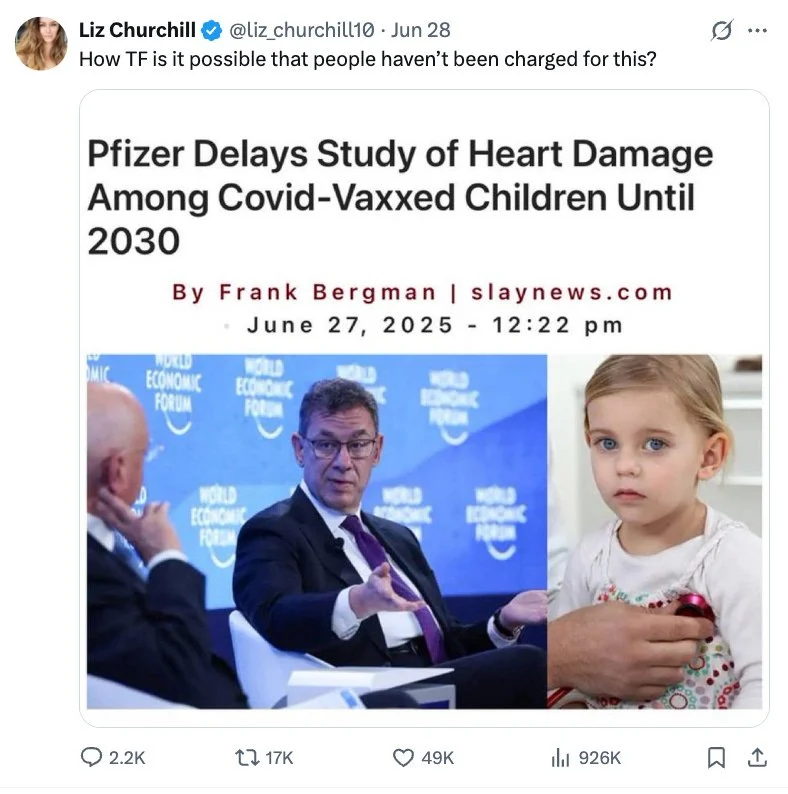Pfizer's Delayed Myocarditis Study
A little bit of knowledge can be a dangerous thing
This headline has garnered so much attention on social media that I was asked to participate in an interview last night to discuss the topic. First, I had to clarify that I cannot be interviewed about ACIP issues without prior clearance from HHS Communications. Once that was understood, at 6:00 PM (dinner time!) I dialed in via Zoom, and we talked on the record. No, I do not know if or when the interview will be aired. Before the interview, as usual, I did the necessary diligence to avoid embarrassing myself due to ignorance, keeping in mind the first rule of social media.
It is often better to stay quiet and have people wonder if you are ignorant than to tweet and remove all doubt.
Let's dive into the details. I think that this particular situation provides a great example of how bias, combined with insufficient background and subject matter experience, can lead to unjustified clickbait headlines. This is a chronic problem on both sides of the mRNA “vaccine” safety debate, one which makes it so, so much harder to get to the bottom of all of this.
I will try to explain so that most can understand, but it may get a little technical. The nuances of clinical research study design and implementation are complicated. Please try to stick it out, if for no other reason than it does lead back to some statements from CDC’s Captain Dr. Sarah Meyer (CDC/NCEZID) during her recent presentation titled “COVID-19 safety update” regarding long-term outcomes from COVID-19 mRNA product myocarditis. Consider that an embedded easter egg.
To illustrate how much traction this article received, below is a clipped post from Canadian influencer Liz Churchill, which has garnered about a million views as I write this. Now, I have no issues with Liz Churchill. She follows me, pretty sure I follow her. She often posts content I find interesting. She does tend towards being a bit strident, and like many (particularly some Canadians), she has been radicalized by what we all have experienced during the COVIDcrisis. But for the sake of discussion, let’s look at Mr. Frank Bergman’s alarming Slay News article that she was posting about from the point of view of the question in her “X” post. Rephrasing and dialing the rhetoric back a bit, Liz basically poses the question, “Why is it legal for Pfizer to delay this study until 2030?”
As a starting point, when asked to comment with a video record, my first reaction was to go along with this narrative. Pfizer and FDA had clearly previously attempted to keep adverse event data concerning the “Comirnaty” mRNA product from independent scrutiny for a very long period of time, and it took legal action and a court order to get those data released.
Querying Grok on the topic with the question “Did Pfizer and FDA try to hide adverse event data about Comirnaty?” yielded the following summary conclusion:
While delays in data release and trial oversight issues raised suspicions, there’s no conclusive evidence that Pfizer or the FDA systematically hid adverse event data. The FOIA process, though slow, followed legal protocols, and adverse event reports were publicly accessible, with limitations clearly stated. However, skepticism persists due to the initial timeline, whistleblower allegations, and distrust in institutional transparency.
Well, that is one AI’s interpretation of events. I personally take a bit darker view of what happened in light of the assertion that it would require until 2076 to release these documents. Still, in the end, the data were disclosed, as I had suggested to Steve Bannon the War Room Posse was recruited to review the documents. Feminist writer, PhD Dr. Naomi Wolff (neither trained nor experienced in science or medicine), then published her summary of their findings.
I think that we can all agree that, in the context of Pfizer, FDA, and Comirnaty, “distrust in institutional transparency” is an understatement. When viewed through that experience, this Slay News headline appears as the same three players coming together again to rub salt into the gaping wound of public trust. I admit that was my reaction when I saw posts about the article. Here they go again. What arrogance! New administration, and still the same old… stuff. Kick the can down the road to avoid accountability. Yawn. Old news. Move on to the next click.
It's a good thing that I took the time to look into the details before the interview and didn't make a fool of myself by jumping to conclusions on camera. I hope that by describing the steps I took to try to figure out what was really going on, I can teach others how to fish instead of just giving them a fish (yes, a metaphor).
I had no idea which study the headline referred to, so discovering that was the first step. All US Phase 2-4 clinical trials (and many foreign ones) are required to be entered into a US Government-maintained (National Library of Medicine) database, found at www.clinicaltrials.gov. So I started there.
What did I know about this trial? It involved Pfizer, Comirnaty, myocarditis, and children/adolescents. So I entered those search terms. Up popped only one clinical trial, “A Study to Learn About The COVID-19 (Study) Vaccine (Called COMIRNATY) in People That Are Less Than 21 Years Old”, ClinicalTrials.gov ID NCT05295290. I wrote to the person requesting the interview, and she confirmed this was the study. Took me about, maybe, two minutes? It had taken her a long time to track it down, including (per her) a call to Pfizer - which firm was apparently baffled concerning what the fuss was all about, as they had disclosed that the trial would be delayed quite a while ago. Interesting. Not defensive, but rather confused. Another data point for my little investigation. Which needed to be completed in the remaining 45 minutes before the interview.
Next step: I read about the trial on the clinicaltrials.gov website. Opened the tabs and read them. I thought about the study design, study size, enrollment criteria, endpoints, follow-up period, who designed the trial, the clinical site network involved, that sort of stuff.
Why focus on these things? Because I have been involved in designing and managing hundreds of vaccine-related clinical trials. I am experienced, have built timelines and project management documents, and know what things commonly cause trial delays.
This is a three arm trial, targeting enrollment of 300 total of either gender (yes, Pfizer and FDA both know there are only two genders), less than 21 years. Two of the arms require onset of stringently defined clinical myocarditis basically presenting to a hospital and beginning 7 or fewer days after Comirnaty administration. The third arm enrolls similar patients using similar criteria but with myocarditis post COVID-19 disease. Presumably 100 confirmed myocarditis patients in each.
Oh, oh. Red flags on the field already.
Even early on, when lots of under 21yo (of both genders) were accepting the product (remember myocarditis was widely denied and derided as a side effect, and reports of myocarditis were frowned upon by elite physicians and social media narrative enforcers), it would be hard to enroll this study. I took a moment to query an AI about current rates of mRNA vaccine uptake in this population. Answer- 15%. Then I looked at how many clinical research sites had been opened in the effort to recruit these 300 kids. 32 sites.
For those unfamiliar with the specialized field of clinical research, establishing and operating a clinical research site is both expensive and time-consuming. Opening 32 sites for a study to enroll 300 patients immediately tells you that the study sponsors think that this is going to be wicked hard to enroll enough patients into this study.
Which leads to the next question - who developed this study? Answer- Pfizer, and the NIH Heart, Lung and Blood Institute. With the hidden hand of the FDA in the background. A seasoned, experienced team. The site network involved is not some fly-by-night private clinical research organization. It is a seasoned, existing site network sponsored and managed by Heart, Lung and Blood. Looking through the enrollment criteria, required testing, follow up testing etc. what I find is a rigorous Phase 4 (post marketing), minimally interventional prospective trial. What does that mean in simple terms? Lots of hard work required to get this done.
What about follow up timelines? In other words, once a child or adolescent meeting the rigorous criteria for myocarditis has been identified, and their parents have consented to participate, and enrollment has been completed, then the child will be subjected to a five-year testing follow-up with lots of fancy hospital tests during that five-year period.
Yipes! When I read that, it translates in my head to “lots of risk of patient loss to follow up”. This will result in headaches during statistical analysis. This study is likely to end up with descriptive summaries of results together with a whole lot of “not statistically significant". In my opinion.
Which leads to the question of why the study is so complicated, the enrollment criteria so stringent, and the follow-up period so long?
Basically, the answer is because this team is really trying to design as rigorous a study as they can to answer the question “what are the long-term consequences of less than 21-year-olds developing myocarditis after either COVID-19 disease or receiving Comirnaty?” This is designed to be the definitive study to answer the question. And of course, this requires a long-term follow-up!
Now, could the FDA have insisted on interim study reports? Yes, and maybe they did (although I do not see that on the clinicaltrials.gov website description.) But interim analyses can really mess with the final statistical analysis, and at 100 children per study arm, that is already going to be pretty tenuous, statistically speaking. So you’re dammed if you do and dammed if you don’t. Pick your poison. Clearly FDA and the Pfizer/NIH team decided to err on the side of being as rigorous as they could. Which seems to me like a good decision.
Returning to my reworded version of the question posed by Liz Churchill. “Why is it legal for Pfizer to delay this study until 2030?”
Think this through with me. We are currently in 2025. This Pfizer comparative study of myocarditis outcomes post COVID-19 versus post Comirnaty, required by FDA, is having trouble getting fully enrolled. And it is likely to get even harder now, because COVID-19 disease is less severe than it was early on. More infectious, less severe, just like I (and many others) predicted would be the case over time. But that means that, just focusing on the comparison arm (post-COVID Myocarditis), it is going to be wicked hard to complete enrollment, for this arm alone regardless of what is going on post Comirnaty.
Then there is the five-year follow-up period on every single patient enrolled in the trial, including the last patient. Of course it will not even close data capture until 2030!
And then there is the lengthy process of database lock, data cleaning and analysis of a very complicated data set. And then the report has to be written. This study will probably have to deal with personnel retirement issues, it will last so long!
No sign of anything nefarious.
Hypothesis: “Pfizer is just trying to delay until it no longer matters” - Rejected.
Occam’s razor- the simplest hypothesis that explains the data is the most likely.
Simplest hypothesis- challenging enrollment combined with long follow-up period means that, assuming that they have not completed enrollment yet - I predict that this final study report will be delayed even past 2030. For entirely understandable (and predictable) reasons.
No wonder Pfizer press communications people are basically saying “Huh? I don’t get it. What’s the fuss all about?” Because there is no “there” there.
In short, “Dear Liz Churchill (and others), not even close to a crime. So, of course, no prosecution. Should we prosecute Pfizer (and Heart, Lung and Blood, and FDA) for the crime of not being able to rapidly enroll a seriously challenging study AND not being able to step into a time machine and come back with the outcome? I think not.”
Now for the not-so-hidden easter egg.
CDC’s Captain Dr. Sarah Meyer (CDC/NCEZID), during her recent ACIP presentation titled “COVID-19 safety update” regarding long-term outcomes from COVID-19 mRNA product myocarditis, assured the nation that post mRNA vaccine myocarditis, while a real risk, resolves completely without long-term problems.
Frankly, that statement was verifiably false.
Whether the post-Comirnaty-associated clinical myocarditis OR the post-COVID-associated clinical myocarditis afflicting those unfortunate few who develop this disease (note the hopeful, optimistic forward-looking statement…) fully recover without long-term consequences is not known. Because the specific long-term study designed to answer that question has not even completed enrollment.
So, at this point, I have to conclude;
There is nothing nefarious that I can find in the delayed timeline for completing Pfizer’s “Study of Heart Damage Among Covid-Vaxxed Children”.
The ACIP presentation statement of CDC’s Captain Dr. Sarah Meyer is a very different matter entirely.
If someone wants to get clicks, likes, and follows by spinning up outrage on social media, the latter point has more merit than the former.



